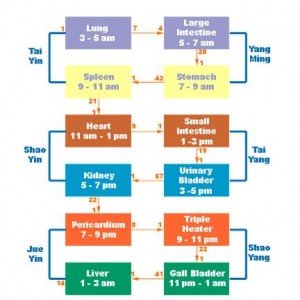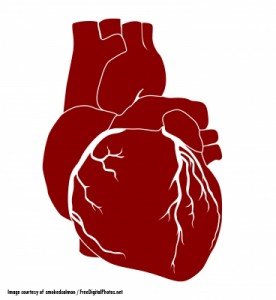[Scientific Qi Exploration]
Horary Cycle’s Qi Pathways from 3 a.m. to 3 p.m.
(Part II)
The Horary Cycle with Exit and Entry Points
Recall that each Organ and its corresponding Meridian energy is at its peak during the two hour period indicated in the diagram below of the Horary Cycle and is at its minimal during the two hour period twelve hours later.
The Horary Cycle can be used to maintain maximum health by adjusting lifestyle in accordance to the body’s natural biorhythms. For example, breakfast should be the most nutritious meal, since the Stomach is most active between 7 and 9 a.m., in accordance with the saying, “Breakfast like a king, supper like a pauper.” The Gall Bladder will be weakest energetically from 11p.m. to 1 p.m. and so even healthy people should avoid heavy, fatty lunches which require large amounts of bile production.
The times of appearance of symptoms of disease can also be predicted. Heart attack resulting from excess Qi occurs frequently between 11 a.m. and 1 p.m. In contrast symptoms of Heart deficiency, such as heart failure and breathlessness, tend to occur between 11 p.m. and 1 a.m.
Gallstone pain will be more severe between 11p.m. and 1 a.m., when the Gall Bladder has its maximal energy. Low back pain, which is a symptom of excess Kidney Qi, is likely to be more noticeable between 5 to 7 p.m., while if the Kidneys are deficient, then low vitality will be experienced from 5 to 7 a.m.
The Horary cycle is also used in some martial arts for striking acupoints to incapacitate an attacker.
In order to eliminate jet lag, the body clock must be reset so that Horary Cycle functions in the same time as the local time of the destination. Stimulating specific Horary Points on the body allows the energy to transfer from one meridian to another, thus helping the biological clock update itself in mid-flight – see http://yang-sheng.com/?p=8973
The peak periods can be used therapeutically to work on specific Organs. For example, a good time to practice Heart Qigong is between 11 a.m. and 1 p.m. The time to practice to cure ulcers or digestive problems is between 7 and 9 a.m.
5. The Lung (Hand-Taiyin) Meridian
See http://www.acumedico.com/lung.htm
The main channel originates internally from the Middle Burner and runs down to connect with the Large Intestine. From there, it ascends along the upper orifice of the Stomach, passes through the diaphragm and branches to enter both Lungs. Two branches from the Lungs merge and ascend to the pit of the throat, where this single channel separates again into two channels that traverse below the clavicle. These two main channels surface externally at L 1 (Zhongfu) and descend down both arms.
Descending along the bicep to the outside of the Pericardium and Heart Meridians the Lung Meridian reaches the cubital fossa at L 5 (Chize). Then, it runs down along the radial side in the front of the forearm and enters Cunkou (the radial artery of the wrist for pulse palpitation). Passing along the radial border of the thenar eminence, it courses along the radial side of the thumb and ends near (.1 cun) the posterior corner of the nail at L 11 (Shaoshang).
A branch emerges from L 7 (Lieque) and runs directly to the radial side of the index finger, where it links with the Large Intestine Meridian at LI 1 (Shangyang), near (.1cun) the posterior corner of the nail. 
6. The Large Intestine (Hand-Yangming) Meridian
See http://www.acumedico.com/colon.htm
The Large Intestine Meridian starts near the posterior corner of the nail at LI 1 (Shangyang) and ascends along the radial side of the index finger. It passes through the interspace of the first and second metacarpal bones LI 4 (Hegu) and the depression between the extensor pollicis longus and brevis tendons. Then, it runs up the lateral side of the forearm to the elbow at LI 12 (Zhouliao). From there, it ascends along the lateral anterior of the upper arm to its highest point on the shoulder LI 15 (Jianyu); then, along the anterior border of the acromion to go up to the 7th cervical vertebra to Du 14 (Dazhui), an acupoint on the Governing (Du) Meridian, which is the confluence of the three Yang Meridians of the hand and foot. It descends to the supraclavicular fossa, where it forms two branches. One branch descends to connect with the Lung Organ and passes through the diaphragm to enter the Large Intestine Organ.
The other branch runs upward to the neck, passes through the cheek and also forms two branches. One branch enters the gums of the lower teeth. The other curves around the upper lip, crosses the philtrum and ends in the nasolabial groove, at the level of the lateral border of ala nasi (LI 20, Yingxiang). Note that the Meridian from the right hand and left hand terminate on the left and right sides of the nose, respectively. LI 20 is the linking point to the Stomach Meridian.
7. The Stomach (Foot-Yangming) Meridian
See http://www.acumedico.com/stomach.htm
The Stomach Meridian starts at the lateral side of ala nasi from LI 20. I ascends to the bridge of the nose, where it meets the Bladder Meridian at B 3 (Jingming) near the inner corner of the upper eyelid. Turning down it reaches S 1 or St-1 (Chengqi) and enters the upper gum. Reemerging, it turns around the lips and descends to meet the Extraordinary Ren Meridian at Ren 24 in the mentolabial groove. Then it runs postero-laterally across the lower cheek at S 5 (Daying) to S 6, ascends in front of the ear and crosses G 3(Shanggun) on the Gallbladder Meridian. Next, it follows the anterior hairline and reaches the forehead.
Another branch emerges in front of S 5, descends to S 9 (Renying) and continues down the throat to enter the supraclavicular fossa. Descending internally, it passes through the diaphragm to its pertaining Organ, the Stomach, and connects with the Spleen.
The external branch from S 9, descends and passes through the nipple, runs by the umbilicus to S 30 in the lower abdomen. An internal branch from the lower orifice of the Stomach descends inside the abdomen to join this external branch at S 30.
The external branch runs down to the thigh traversing S 31 (Biguan) and S 32 (Femur-Futu) and reaches the knee. Continuing downward along the anterior border of the lateral tibia, it passes through the dorsum of the foot to reach the lateral side of the tip of the second toe at S45 (Lidui).
The tibial branch from S 36, 3 cun below the knee, enters the lateral side of the middle toe.
Another branch, from the dorsal foot, emerges from S 42 (Chongyang) to link with the Spleen Meridian near the medial side of the posterior border of the nail of the big toe at Sp 1 (Yinbai).
8. The Spleen (Foot-Taiyin) Meridian
See http://www.acumedico.com/spleen.htm
The Spleen Meridian begins near the medial side of the posterior border of the nail of the big toe at Sp 1 (Yinbai). It runs along the medial aspect of the foot along the border of the red-and-white skin and ascends in front of the medial malleolus to Sp 5. Then, it runs up the medial aspect of the leg along the posterior border of the tibia to Sp 9, on the lower border of the medial condyle of the tibia and reaches Sp 10. Continuing up the anterior medial aspect of the thigh it reaches the lower abdomen at Sp 12. Passing through Sp 13, it connects Ren 3 and Ren 4 and then flows through Sp 14 and Sp 15 to Ren 12.
The external branch, from Ren 12, continues up the chest to Sp 20 and then descends along the lateral aspect of the chest to terminate on the mid-axillary line in the seventh intercostal space at Sp 21.
The internal branch from Ren 12 enters its pertaining Organ, the Spleen, and also connects with the Stomach. The branch from the Stomach goes up through the diaphragm and a branch flows into the Heart to link with the Heart Meridian. The other branch runs up along the esophagus and reaches the root of the tongue, where it spreads out over its lower surface.
9. The Heart (Hand-Shaoyin) Meridian 
See http://www.acumedico.com/heart.htm
Three energy rivers originate from the Heart. One descends to permeate the Pericardium; then, descends further to connect with the Small Intestine. Another ascends along the esophagus to meet with the tissues connecting the eyes to the brain. The third goes upward to the Lungs; then, turns downward to emerge in the center of the axilla at H1 (Jiquan). Then, it descends along the posterior border of the medial aspect of the arm to terminate at H 9 (Shaochong), on the radial side of the little finger, about .1 cun posterior to the corner of the nail. Here it links with the Small Intestine Meridian at SI 1 (Shaoze), on the ulnar side of the little finger, about .1 cun posterior to the corner of the nail.
10. The Small Intestine (Hand-Taiyang) Meridian
See http://www.acumedico.com/si.htm
The Small Intestine Meridian begins at SI 1, follows the ulnar side of the dorsum of the hand, runs through the bony cleft of the radial styloid process at SI 6 (Yanglao), passes between the ulnar olecranon and the medial epicondyle of the humerus at SI 8 (Xiaohai) and runs along the posterior border of the lateral aspect of the upper arm to the shoulder at SI 10 (Naoshu), in the depression inferior to the scapular spine. Zigzagging in the scapular region it meets it meets Du 14 (Dazhui) and turns downward to the supraclavicular fossa, where it branches.
The internal branch connects with the heart, descends along the esophagus and passes through the diaphragm to enter the Small Intestine, its pertaining Organ.
The external branch ascends the neck to SI 17 (Tianrong) in the depression posterior to the mandibular angle and anterior to the sternocleidomastoid muscle. At SI 17 it branches and one branch runs across the cheek to the outer canthus and then to SI 19 (Tinggong), where it enters the ear.
The second branch ascends to the infraorbital region passing through SI 18 (Quanliao) and further to the lateral side of the nose reaching the inner canthus to link with the Bladder Meridian at B 1 (Jingming).
Marty Eisen, PhD – a retired scientist, who constructed mathematical models in medicine. He has studied and taught Yoga, Judo, Shotokan Karate, Aikido, Qigong, Praying Mantis Kung Fu, and Tai Chi. Dr. Eisen studied Chinese Medicine through apprenticeships and correspondence courses . His latest project is to help arrange free courses for veterans in Chow Qigong for health or as a vocation – see http://eastwestqi.com/. For more information about Dr. Eisen please visithttp://home.comcast.net/~carolezak


Pingback: Harmony With Nature: Healing Rhythms – Human, Moon, Earth, and Sun | Yang-Sheng